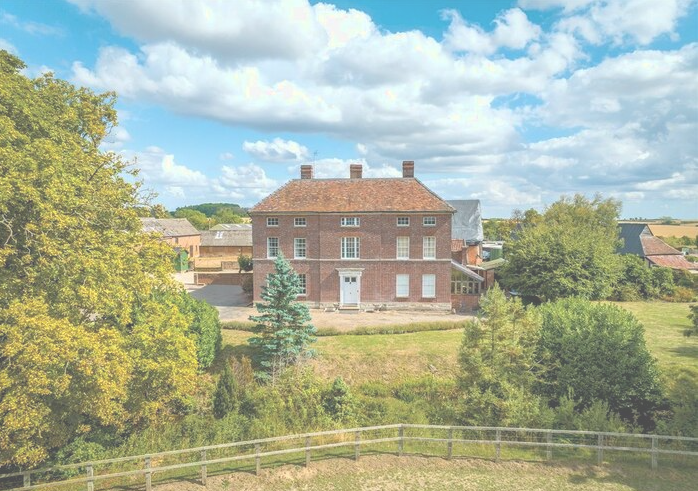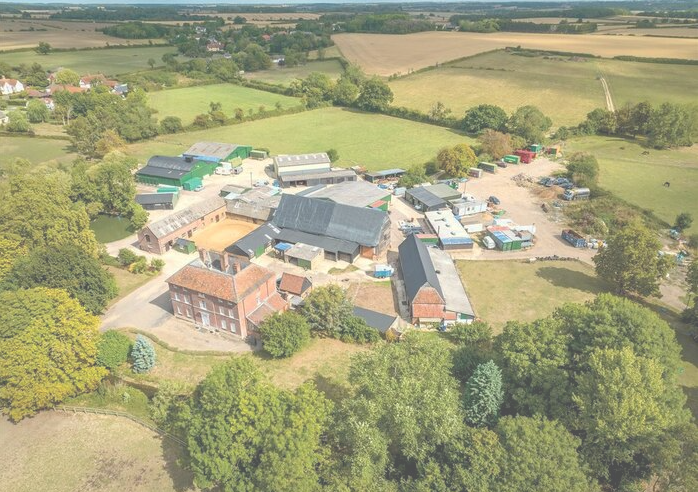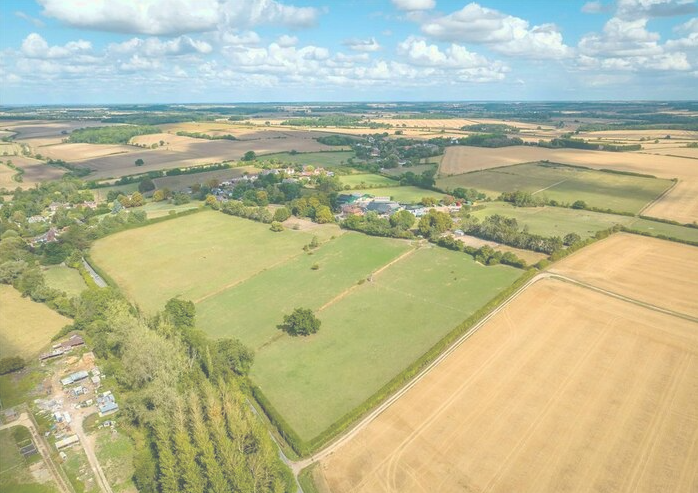- Home
- /
- Nunn research
- /
- Nunn families in Withersfield,...



Joshua Nunn’s home, Hall Farm, Withersfield: estate agent photos from 2022.
The location of Withersfield presents issues for anyone researching the people who lived there. It shares a border with Cambridgeshire, next door to Shudy Camps and Horseheath. Immediately to the south, there’s Haverhill, which is on the Essex border, and in fact, part of Haverhill is in Essex. This means there are three counties to search if you want to make sure you cover all bases.
The first appearance of anyone by the name of Nunn in Withersfield, in the far south-west of Suffolk, are John Nunn and his wife Anne, with the baptism of their daugther Anne there on 29 March 1706. John and Anne had married in Little Wratting, just south-east of Withersfield, on 26 Feb 1705. He was a widower, although I haven’t yet found his first marriage or where he came from before arriving in Withersfield.
Between 1707 and 1712, John and Anne had four more children: Robert in 1707, an unbaptised child in 1709, Sarah in 1710, and Henry in 1712, but all these children died in their infancies. In 1713, along came another Sarah, then Joshua in 1715, Hannah in 1717 and Susannah in 1720. These four last children appear to have survived into adulthood.
Sadly, John’s wife died in 1720, presumably in childbirth, as Anne was buried on the very same day as Susannah was baptised.
I haven’t been able to trace John and Anne’s daughters any further, but Joshua remained in Withersfield, so we know what happened to him.
In early May 1737, arrangements began to be made for 22-year-old Joshua’s upcoming marriage to local woman Elizabeth Pruer (or Prewer). The archives in Bury St Edmunds hold two documents related to this,[1]References: HA517/3/9/5 and HA517/3/9/6 concerning a great deal of property: a double messuage called Lisfeilds in Haverhill, a farmhouse and 20 acres in Clare, 16 acres of land in Stoke by Clare, a messuage by Button Greene, Withersfield, a messuage and barn, 3 acres of land 1 acre meadow all in Withersfield, 3 acres in Brookshole, Withersfield, and a messuage and 5 acres of land in Linton, Cambridgeshire. The property was effectively in trust to two gentlemen, who the Nunns and Pruers must have believed to be honest, good men: Mortlock Coldham, gentleman of Haverhill, and Henry Twinn of Little Linton, Cambridgeshire. The property belonged to the Nunns, who passed it to the trustees. The marriage agreement allowed for John Nunn to occupy it for life, followed by his son Joshua, and afterwards, should she outlive Joshua, his intended bride, Elizabeth Pruer.
Elizabeth’s father, Robert Pruer, had died intestate the year before, and as his widow left a will, it seems that she automatically inherited property that could be Elizabeth’s later. It seems that the marriage settlement set up for Joshua and Elizabeth was to put aside some – or all – of the Nunns’ property to ensure Elizabeth’s future security, should she be widowed.
Joshua and Elizabeth married in Risby, 33 miles north-east of Withersfield. It seems strange for them to travel all that way when they both lived in Withersfield; besides, with a marriage settlement agreed on, it wasn’t as if they were running away to marry due to family opposition. The reason they chose Risby seems to be down to family ties. A Robert Nunn owned the Manor of North Hall in Risby at the time, and he might be related to Joshua. However, there is a solid connection with Elizabeth Pruer and Risby. The couple married by licence and their bondsman was Robert Garland of Risby, a yeoman. In 1719, Robert Garland had married Susan Pruer, who appears to have been Elizabeth’s first cousin, a daughter of Thomas Pruer by his first wife, Susan. Thomas’ second wife, Frances, wrote a will in 1723, days before her death, where she mentions her goddaughters, who were children of two men, John “Garling” and Robert “Garling” – John had married Anne Pruer, Susan’s sister, and the two Garland/Garling men were brothers. Elizabeth was an only child, so it seems plausible that she would want to get married in Risby near her cousin. Perhaps Susan was even her bridesmaid, you never know.
There’s a very tantalising hint of another connection. Frances Pruer, Elizabeth’s aunt by marriage, had been born Frances Sparke in Hawstead, and there were several marriages between the Sparkes of Walsham-le-Willows and the Nunns of North Hall Manor. It would be interesting if Joshua was related to those Nunns, and that Elizabeth’s aunt was related to those Sparkes. Or of course, it could be nothing but a coincidence thanks to the geographical frequency of certain surnames!
Joshua and Elizabeth headed back to Withersfield, where they had seven children between 1740 and 1750. Their sons John (baptised 1740), Joshua (baptised 1742), and Robert (baptised 1745) all survived infancy, but sadly a daughter Elizabeth (1743) and three sons, all named Haylock (1747, 1748, 1750), died very soon after their births.
Joshua’s father John died just before his son John was baptised – John was buried in Withersfield on 25 May 1740, and Joshua and Elizabeth’s son was baptised four days later, presumably named after his late grandfather.
While working to raise his young family, Joshua was dragged into Chancery cases,[2]The National Archives references: C 11/2499/8, 1747 and C78/1877. 30 June 1749. The papers from the case in 1749 have been digitised and are available to view online at the University of … Continue reading thanks to a man he had once trusted: Mortlock Coldham. John Nunn was the undertenant of the Rectory, which was owned by several members of the Perrin family. Mortlock was farming it, and was supposed to pay tithes, but he went out of his way to avoid doing so and kept coming up with reasons and excuses why he didn’t have to. He was even insulting to the Nunns, telling them he would ruin them. It isn’t surprising it went to court, but one wonders what happened about Joshua and Elizabeth’s marriage settlement, which Mortlock was trustee for. Mortlock’s scurrilous ways caught up with him in 1765 when he was charged by the Crown with perjury.[3]A copy of the papers relating to this case are held at the Norfolk Record Office, reference WLS LV/39, 428X5. Mortlock fled the country, and died in Boulogne, northern France.[4]The National Archives: Prerogative Court of Canterbury will of Mortlock Coldham of Boulogne, written 15 Feb 1775, probated 22 Dec 1777.
Elizabeth died only a year after her last child was born, and was buried in Withersfield, leaving Joshua a widower with three small boys. It’s possible that Joshua’s mother-in-law, Elizabeth Pruer, helped to raise the boys, as she was still in Withersfield. She wrote her will on 16 July 1751, describing herself as the widow of Robert Pruer, yeoman, and names her three grandsons: John, Joshua, and Robert Nunn. They were her only beneficiaries. She owned several pieces of real estate – she mentions some land specifically, which she had bought from Joshua, then her real estate, without telling us if it was just land or if it included any houses too.
John was left a piece of land, and all the boys were to receive household goods and money. The household goods included several silver spoons, which Elizabeth described as being marked with IH, TK, and LH. It seems likely that she had herself inherited these spoons, and when we bear in mind that Joshua and Elizabeth tried three times to name a son Haylock Nunn, it seems very likely that someone in Elizabeth’s family was a Haylock. I haven’t found the record of her parents’ marriage, so it seems likely that her mother’s maiden name was Haylock – there were several people by that name living in Withersfield. Elizabeth was buried in Withersfield on 20 Feb 1756.
Elizabeth’s executors were William Claydon and Richard Pettit junior, both of Haverhill. Richard was a shopkeeper, and on the same day that he proved Elizabeth’s will, he also proved that of his father, Richard Pettit senior, also a shopkeeper. Richard jnr didn’t swear to perform the will, but made his “solemn and sincere declaration of affirmation”, which tells us that he was a Quaker.
Fifteen years would pass after Elizabeth’s death before Joshua married again. He walked down the aisle of Withersfield church on 19 Feb 1765 with Jane Flack, who had been a widow for ten years.[5]They married by licence. Their bondsman was Thomas Purkis of Withersfield. He’s presumably Thomas Purkis senior who was buried in Withersfield on 14 Sep 1801, the register telling us that he … Continue reading
Jane had been married to Anthony Flack of Withersfield, and they’d had six children between 1741 and 1753: Robert 1741, twins Mary and Jane 1743, Anthony 1746, John 1749, William Gazaway (or Garaway?) 1753. In 1747, Jane herself was baptised, the register telling us that she had been born a Quaker. It doesn’t tell us her parents’ names, however, only that she was Anthony’s wife. It’s interesting that Joshua’s second wife had come from a Quaker family, when his mother-in-law had trusted her estate to a Quaker too. I don’t know if Jane’s family were connected to Richard Pettit’s, and it could in fact just be a coincidence, as there was a Quaker meeting house in Haverhill and a Presbyterian chapel, too, so there were quite a few non-conformists living near Withersfield.
It’s possible that Jane was born Jane Quilter: a marriage took place at Little Shelford in Cambridgeshire on 19 May 1739 between Anthony Flack and Jane Quilter, both of Newton. Little Shelford is about 16 miles north-west of Withersfield, and Newton is just south of Little Shelford.
Jane died in 1796; she was buried in Withersfield on 15 July that year. Joshua lived nearly a decade later; he died on 10 Feb 1805,[6]Death notice published in the Bury and Norwich Post, 27 Feb 1805. and was buried in Withersfield three days later. The parish register tells that he had lived at Hall Farm, Withersfield, the tenant of Charles, Duke of Somerset.
Joshua wrote his will on 7 March 1800 and asked to be buried in Withersfield churchyard, as he was. It appears that his son Joshua had predeceased him, as he only mentions John and Robert in his will. John, he tells us, was living in Linton, Cambridgeshire, and Robert in Haverhill. He tells us that his sons had children, but doesn’t name them.
John Nunn of Linton, Cambridgeshire
John Nunn married a woman called Susannah or Elizabeth – her name keeps changing between baptisms but she was buried as Susannah. Their children were:
- Thomas Mundy, baptised 5 Nov 1777: moved to London
- Susannah, baptised 5 Nov 1780: moved to London
- Elizabeth, born 23 Aug, baptised 5 Sep 1784, died 1786
- John, born 28 Sep, baptised 8 Oct 1786 [not traced any further]
- Elizabeth, born 27 Jan, baptised 14 Feb 1790, died 1790
- William, born and baptised 4 July 1792: moved to London
Susannah died in 1804 and John in 1817; both were buried in Linton.
Their son Thomas moved to London and married Susannah Marks at St Pancras’ church on 8 Sep 1811. He was an oilman and grocer, and when he died in 1844, The Morning Post said he’d been at the same address, Great James Street in Holborn, for 38 years. More information about Thomas can be found with the transcription of his will.
John and Susannah’s youngest child, William, moved to London, and married Mary Scotcher at St Giles-in-Fields on 25 July 1813. He was a tailor, and his wife was a midwife. On the 1851 census, they were living at 3 Suffolk Street in St Pancras. They had least five children. William died in 1858.
The only surviving daughter of John and Susannah had a difficult life; she was married no less than four times. She married her first husband, James Salmon, in Linton on 30 July 1803, and they had four children: Eliza Pruer, Thomas Mundy, John Nunn, and Susannah Nunn, but only one child, Eliza Pruer Salmon, survived. James passed away, presumably between 1807 and 1810, as Susannah married her second husband, a widower called James Smith, at Linton on 13 March 1810. He died too, so on 8 Sep 1820, Susannah walked down the aisle for the third time, to find Mark Benton at the altar rails waiting for her. By now, Susannah was living in Cambridge, and their marriage took place at Holy Trinity. But Mark died, and Susannah decided to attempt matrimony for a fourth time. This time, she married James Snare, a widower from Brandon in Suffolk, at St Andrew the Less in Cambridge. They appear on the 1841 census living Stepney, but may have moved to London earlier than that as Susannah’s only surviving child, Eliza Pruer, had married Zaccheus Hunneybell in Bethnal Green on 4 Aug 1839. Eliza was already a widow by the time she married Zaccheus: she had a daughter, Jane Johnston, although I don’t yet know who her first husband was. Eliza died in 1849, and Susannah in 1856.
Something to note is that a John Nunn married a Frances Pruer at St Martin’s-in-the-Fields in London in 1771. The combination of surnames makes me think that this must be a connection to Joshua Nunn and Elizabeth Pruer – perhaps the groom was their son John? But I haven’t been able to dig any further.
Robert Nunn of Haverhill and Clare
Tracing Robert was a little more difficult as he lived in Clare before moving to Haverhill, where his father said he was living in 1800. On 20 Dec 1776, Robert married Mary Dearsley in Clare, then on 20 Feb 1777 the couple appear to have got into financial difficulties as poor law records at the Suffolk Record Office show them being “removed” from Clare to Haverhill. Three years later, they returned to Clare, where their first child was born, but then they were back in Haverhill by 1783.
- John, baptised in Clare, 10 Feb 1780
- Joshua, baptised in Haverhill, 20 Oct 1783
- Elizabeth, baptised in Havernhill, 1 Aug 1790
I haven’t researched this family any further at the moment.
by Helen Barrell
Originally published 21st January 2024
Edited 13th March 2024 to include information about Joshua’s will and his two sons, John and Robert.
Footnotes
| ↑1 | References: HA517/3/9/5 and HA517/3/9/6 |
|---|---|
| ↑2 | The National Archives references: C 11/2499/8, 1747 and C78/1877. 30 June 1749. The papers from the case in 1749 have been digitised and are available to view online at the University of Houston’s WAALT. |
| ↑3 | A copy of the papers relating to this case are held at the Norfolk Record Office, reference WLS LV/39, 428X5. |
| ↑4 | The National Archives: Prerogative Court of Canterbury will of Mortlock Coldham of Boulogne, written 15 Feb 1775, probated 22 Dec 1777. |
| ↑5 | They married by licence. Their bondsman was Thomas Purkis of Withersfield. He’s presumably Thomas Purkis senior who was buried in Withersfield on 14 Sep 1801, the register telling us that he had been clerk of the parish for 36 years. He died of small pox. |
| ↑6 | Death notice published in the Bury and Norwich Post, 27 Feb 1805. |
